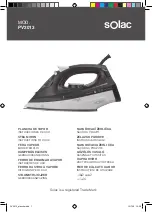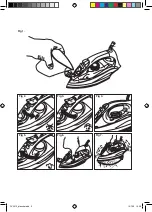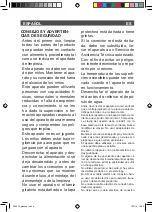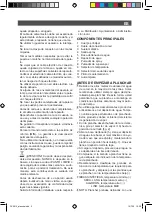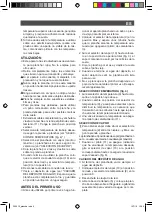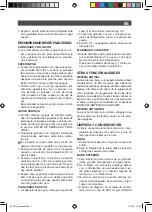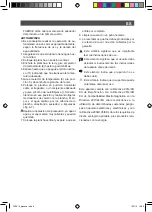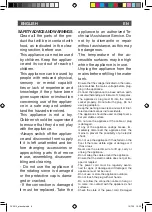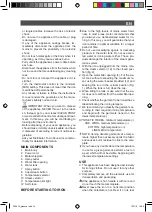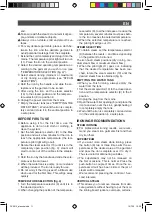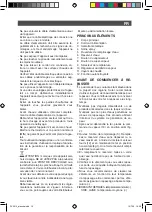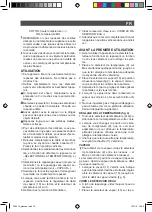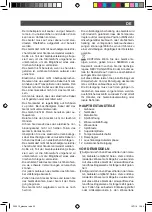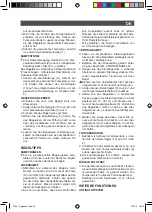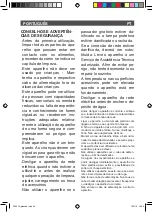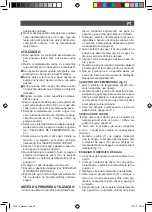
etc.
1 Fill the water tank as explained in the “BEFO-
RE STARTING TO IRON” section.
2 Place the garment on a hanger, well away
from other garments, people, animals, etc.
Do not discharge steam onto a garment han-
ging in the wardrobe or on a person.
3 Set the steam control (10) to the closed po-
sition and the temperature selector (9) to the
Max position.
4. Bring the iron close to the garment, in the
vertical position,( between 15 and 30 cm) and
press the supersteam button (8) once only. Do
not position the iron too close to the garment,
because you could damage it.
5. Wait a few seconds before pressing the button
(8) again, so as not to damage the garment.
Most wrinkles can be eliminated with three
sprays of stea.
DRy IRONING
1 If there is water in the tank, turn the steam
selector (10) to the closed position (fig. 2).
2 Plug in the iron and set the temperature selec-
tor (9) to the desired position.
The pilot light (11) will go off when the tempe-
rature is reached.
IRONINg WITH sPRAY
+
Spray can be obtained by pressing the corre-
sponding button (7) when dry ironing or iron-
ing with steam. The iron is at any temperature
level
•
Press the spray button (7) as many times as
you want to use this function. 3D soleplate:
•
Ceramic soleplate with active tip, equipped
with a metal body ideal for professional iro-
ning of shirt collars,pockets, trouser creases,
etc. Caution. The skirt is an active area of the
soleplate, so it will be hot while ironing.
•
3D Ironing is a way to help with ironing, use it
to iron delicate areas like shirt cuffs, pockets
or skirt and trouser hems. Do not make direct
contact with the skin, and wait for the iron to
cool down completely before touching it.
OTHER FUNCTIONS
ANTI-LIMESCALE SySTEM
This iron has an innovative built-in anti-limescale
system, consisting of a resin filter that retains the
limescale substances from the water, so these
cannot reach the steam chamber of the soleplate,
thus extending the life of the iron.
The existence of this anti-limescale system does
not mean that the recommendations about wa-
ter hardness mentioned in the “BEFORE STAR-
TING TO IRON” section can be ignored .
ANTI-DRIP SySTEM
The iron incorporates an anti-drip system that
prevents the iron from dripping, even when it is
switched ofa.
STORAGE AND CLEANING
+
Clean the appliance after using it for the first
time, immediately after each use and after a
long time without use.
SOLEPLATE
1 Disconnect the iron and allow the soleplate to
cool down.
Use clay-based, environmentally friendly
products to clean the solep.
EXTERNAL PART
1 To clean the external part of your iron, use a
cloth dampened with soapy water.
Do not use solvents or abrasive products to
clean your iron, as these could damage some
of the plastic parts and/or remove some of the
marks.
2 Store your iron in a vertical position, coiling
the cord around the base and pressing the ca-
ble into the fixing clip.
+
Although the power cord is fitted with a 360º
swivel piece, NEVER FORCE this cord when
coiling it around the appliance on the first turn.
SELF-CLEANING
+
It is advisable to carry out the self-cleaning
operation about once a month, depending on
the frequency of use and the hardness of the
water used
1 Ensure that the tank is half filled with water.
2 Place the iron in the vertical position.
3 Plug in the iron and turn the temperature se-
lector (9) to the Max position.
4 Wait for the pilot light to go off (11) indicating
that the desired temperature has been rea-
ched.
5 Turn the temperature selector (9) to the 0 po-
sition and unplug the iron from the mains.
6 Place the iron in the horizontal position over
a sink or an appropriatecontainer and press
the selfclean button (12), keeping the iron in
thisposition and swinging it gently from side to
side. Steam and water willcome out from the
holes in the iron, flushing out dirt and impuri-
EN
PV2013_plancha.indd 12
15/7/16 15:59
Summary of Contents for Optima 2.0
Page 2: ...PV2013_plancha indd 2 15 7 16 15 59 1 4 3 12 6 2 9 11 7 8 10 5...
Page 3: ...Fig 1 Fig 6 Fig 7 Fig 4 Fig 3 Fig 2 Fig 5 PV2013_plancha indd 3 15 7 16 15 59...
Page 59: ...BG 10 c PV2013_plancha indd 59 15 7 16 15 59...
Page 62: ...4 8 5 1 2 3 10 9 Max 4 15 30 8 5 8 1 10 2 2 9 11 7 7 1 BG PV2013_plancha indd 62 15 7 16 15 59...
Page 69: ...AR PV2013_plancha indd 69 15 7 16 15 59...
Page 70: ...AR PV2013_plancha indd 70 15 7 16 15 59...
Page 71: ...AR PV2013_plancha indd 71 15 7 16 15 59...
Page 72: ...AR PV2013_plancha indd 72 15 7 16 15 59...
Page 73: ...PV2013_plancha indd 73 15 7 16 15 59...
Page 74: ...PV2013_plancha indd 74 15 7 16 15 59...

